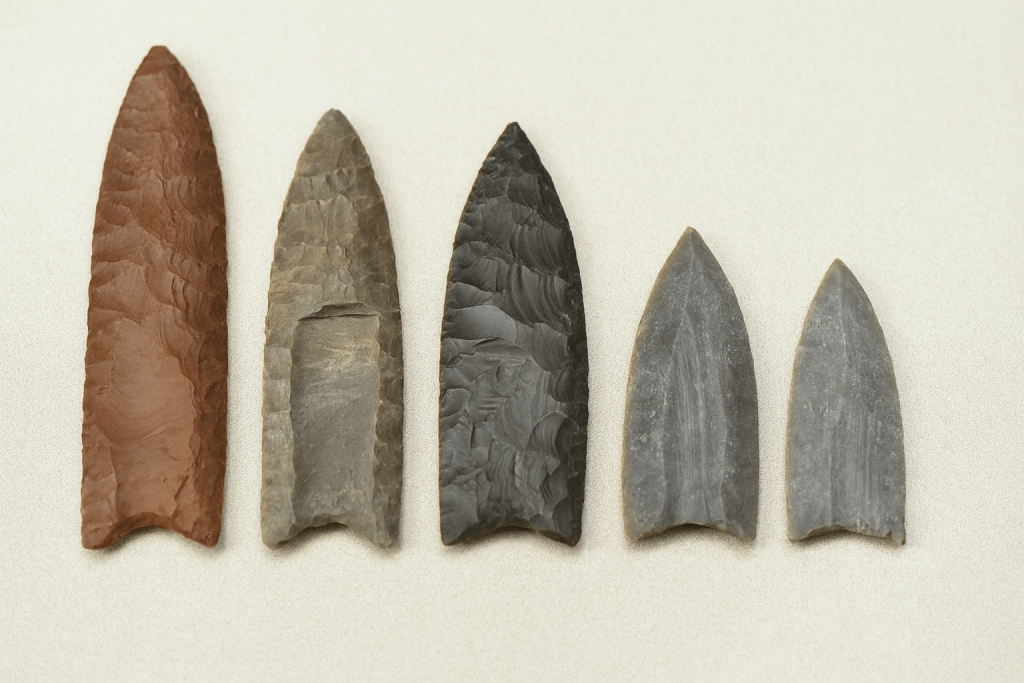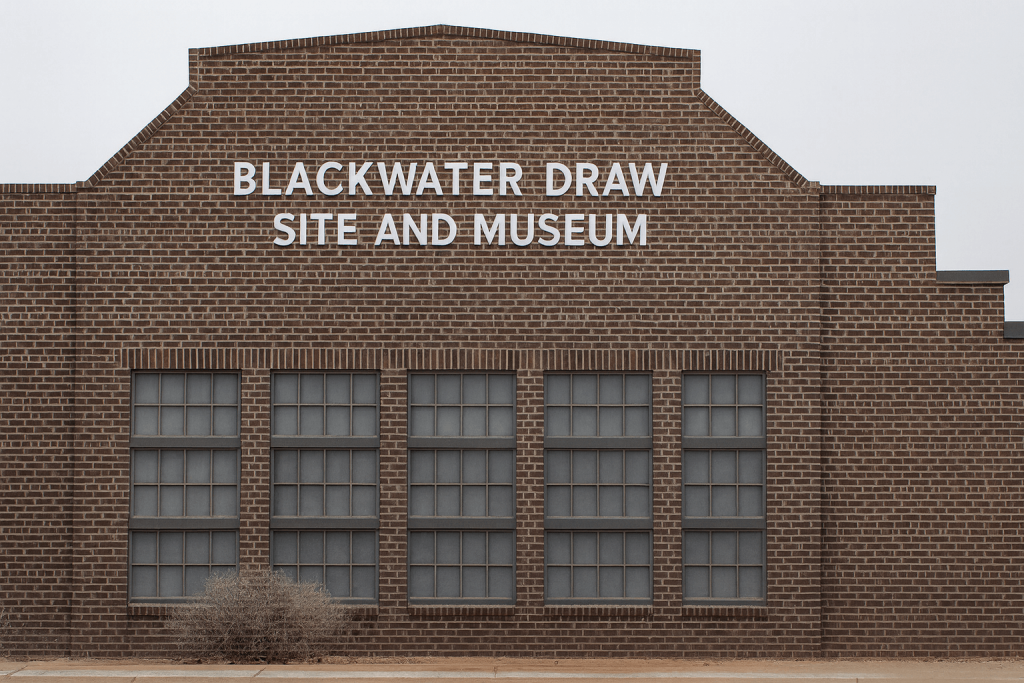Exploring Blackwater Draw: A Journey Into Clovis’ Ancient History
Over 13,000 years ago, ancient hunters gathered at a watering hole in what is now eastern New Mexico. They made stone tools, hunted massive animals, and left behind clues that transformed our understanding of early human history in North America.
This place, Blackwater Draw, is one of the most important archaeological sites in the United States. It’s where archaeologists first uncovered evidence of the Clovis people, some of the earliest inhabitants of the Americas, named after the nearby town of Clovis, New Mexico.
Today, visitors to Blackwater Draw can walk where ancient people once lived and see the site of groundbreaking discoveries, learning about life during the Ice Age.
Read on to uncover how this site in Clovis reshaped our understanding of early life in the Americas.
The Significance of Blackwater Draw
Blackwater Draw earned its place in history books when archaeologists made a stunning discovery in the 1930s. They found distinctive stone spear points buried alongside the bones of extinct animals like mammoths and giant bison. These spear points, now called Clovis points, were unlike anything found before in North America.
The discovery was huge because it proved that humans lived in North America much earlier than scientists had believed. The artifacts at Blackwater Draw date back over 13,000 years, making this one of the oldest known human settlements on the continent.
The Clovis Culture, as archaeologists named these early people, became known as some of the first Americans.
Blackwater Draw changed archaeology forever. Before its discovery, many scientists doubted humans had lived in the Americas for so long. The evidence sparked new research and debates about when and how the first people arrived in North America, reshaping our understanding of early human migration and survival.
The site also showed how these early people lived. They were skilled hunters who worked together to take down huge Ice Age animals. They made sophisticated tools and knew how to use the land’s resources to survive in a challenging environment.
Key Discoveries at Blackwater Draw
The most famous finds at Blackwater Draw are the Clovis points themselves. These stone spear tips are instantly recognizable because of their unique shape and the grooves carved into them. The grooves, called flutes, helped the points attach more securely to wooden spears. Making these tools required incredible skill and knowledge passed down through generations.
Archaeologists have found Clovis points throughout the site, proving that multiple groups of people used this area over many years. Each point was carefully crafted by hand, and no two are exactly alike. The quality of these tools shows that Clovis people were master craftsmen who took pride in their work.

The site has revealed bones of Ice Age animals now extinct. Mammoth bones show cut marks from Clovis hunters, while giant bison remains reveal successful hunts that fed groups for weeks. These discoveries show what life was like when North America was very different.
Scientists have learned that Blackwater Draw was once a natural spring that attracted both animals and humans. The water source made it an ideal place for early people to set up camps and hunt. Geological studies show how the landscape changed over thousands of years, helping explain why this spot was so important to ancient peoples.
Visiting Blackwater Draw: What to Expect
A visit to Blackwater Draw is more than a walk through history. It is a chance to explore the world of the earliest Americans. The site combines preservation with interactive experiences, allowing you to learn while exploring the landscape of key archaeological discoveries in North America.
- Walking Trails – Stroll along paths that cut through actual excavation zones where archaeologists worked. Informational signs along the way explain the findings, helping you imagine what life was like for the Clovis people thousands of years ago.
- Viewing Platforms – Stop at elevated overlooks that let you peer into excavation pits. The exposed soil layers show a timeline of history, with each layer representing changes in climate, wildlife, and human activity over millennia.
- Interpretive Stations – Get a closer look at replicas of tools like Clovis points, displayed at outdoor learning stations. These hands-on exhibits reveal how early hunters crafted weapons sharp and durable enough to bring down mammoths and other giant animals.
- Best Time to Visit – The cooler months make exploring more enjoyable, as summer sun in New Mexico can be intense. Visiting during fall or spring offers comfortable weather and fewer crowds.
- Visitor Tips – Wear comfortable walking shoes, since the trails cover uneven ground. Photography is generally allowed, but some areas may have restrictions to protect ongoing research—always ask staff before taking pictures.
The Blackwater Draw Museum: A Deeper Dive into Clovis Culture

The Blackwater Draw Museum serves as the perfect complement to your site visit. Located nearby, the museum houses many of the actual artifacts discovered during decades of excavation. These aren’t replicas. They’re the real tools and weapons used by people over 13,000 years ago.
Interactive exhibits help visitors understand daily life during the Clovis period. You can learn about hunting strategies, tool-making techniques, and how these early people adapted to their environment. The museum does an excellent job of making archaeology accessible without dumbing down the science.
One of the museum’s standout features is its collection of Ice Age animal fossils found at the site. Seeing the massive bones of mammoths and giant bison up close helps visitors grasp the incredible challenge Clovis hunters faced. These weren’t small game animals. They were enormous creatures that required careful planning and teamwork to hunt successfully.
The museum also offers educational programs and guided tours that provide deeper insights into the discoveries. Staff members are knowledgeable and passionate about sharing the site’s history with visitors. Whether you’re a casual tourist or a serious history buff, you’ll find something valuable here.
The Legacy of Blackwater Draw in Modern Archaeology
Research at Blackwater Draw didn’t stop with the initial discoveries. Archaeologists continue studying the site using new technologies and methods. Modern techniques allow scientists to learn things from old artifacts that weren’t possible when they were first discovered.
Recent studies have used advanced dating methods to get more precise ages for artifacts. Computer modeling helps researchers understand how the Clovis people moved across the landscape and used resources. Each new study adds to our knowledge of these remarkable early Americans.
Ongoing Preservation and Community Support
The site faces ongoing challenges from erosion and weather. Preservation efforts work to protect the excavation areas while still allowing public access. In June 2025, Eastern New Mexico University received more than $10,000 in state funding to help stabilize and preserve two archaeological features at Blackwater Draw.
Funding for these efforts also comes from visitor fees and donations from people who understand the site’s importance, helping ensure that Blackwater Draw remains protected for future generations.
A Global Impact on Archaeology
Blackwater Draw continues to influence archaeological research worldwide. Scientists compare Clovis points to similar tools found in other countries, trying to trace the movements of early human populations. The site remains central to debates about when and how people first arrived in the Americas.
Visitors can support ongoing research and preservation by following site rules and making donations when possible. Every effort to protect Blackwater Draw helps ensure future generations can learn from this incredible place.
Why Blackwater Draw Remains Essential for Understanding Our Past
Blackwater Draw stands as proof that North America has a much longer human history than many people realize. The site connects us directly to some of the earliest Americans, people who faced incredible challenges and succeeded in making a new continent their home.
Visiting Blackwater Draw and its museum offers a unique opportunity to step back in time and understand how our ancestors lived. The combination of outdoor exploration and indoor learning creates a complete educational experience that appeals to visitors of all ages.
For anyone interested in human history, archaeology, or the story of how people spread across our planet, Blackwater Draw is essential. It’s a place where you can literally walk in the footsteps of some of the first Americans and gain a deeper appreciation for their remarkable achievements.

